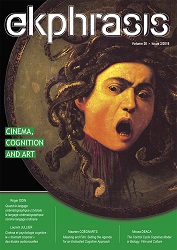Romanian Silent Films from the 20s and the European Aesthetic Canon: Rhetorical Figures and Cognitive Markers
Romanian Silent Films from the 20s and the European Aesthetic Canon: Rhetorical Figures and Cognitive Markers
Author(s): Dominique NastaSubject(s): Film / Cinema / Cinematography
Published by: Universitatea Babeş-Bolyai, Facultatea de Teatru si Televiziune
Keywords: Romanian cinema; early cinema; emo-cognition; emotion; mood in film
Summary/Abstract: It may seem to come as a surprise to Western contemporary film exegesis, but Romanian cinema did produce some isolated interesting and original works in the early years of the 20th century. We will try to demonstrate that though very few silent films have been preserved, at closer scrutiny they do prove very close to the ongoing European aesthetic film canon as developed in France, Germany or Sweden (Abel 1984; Brewster & Jacobs 1997, Bordwell 2002). During the first two decades of its existence, Romanian cinema production teams used well-known literary figures, adapting their novels, plays or operettas. A highly original example from the silent era, Manasse (Jean Mihail, 1925) initially applied by Ronetti Roman about a dramatic event from the Jewish community, isn’t only an authentic melodrama focusing on an impossible love in a Jewish traditionalist family. Filmed on location in different parts of Romania, its dynamic cinematography, editing and acting echoes in terms of aesthetic and ethnic issues the story line from Alan Crosland’siconic Jazz Singer. Horia Igiroșanu’s only preserved film Haiducii (The Outlaws, 1929) an action film on a large scaleabout Balkan musketeers, is another very interesting case of location shooting, dynamic cross-cutting and emancipatedfemale portrayals. Finally, Maiorul Mura (Major Mura, Ion Timuș & Jean Georgescu, 1928) a French vaudeville-like comedy in the line of Maurice Tourneur’s “Serpentin” series, helps pave the way for the first comic talkies featuring sophisticated title cards and a complex aural universe (songs, choreography, choruses).
Journal: Ekphrasis. Images, Cinema, Theory, Media
- Issue Year: 20/2018
- Issue No: 2
- Page Range: 147-156
- Page Count: 9
- Language: English

